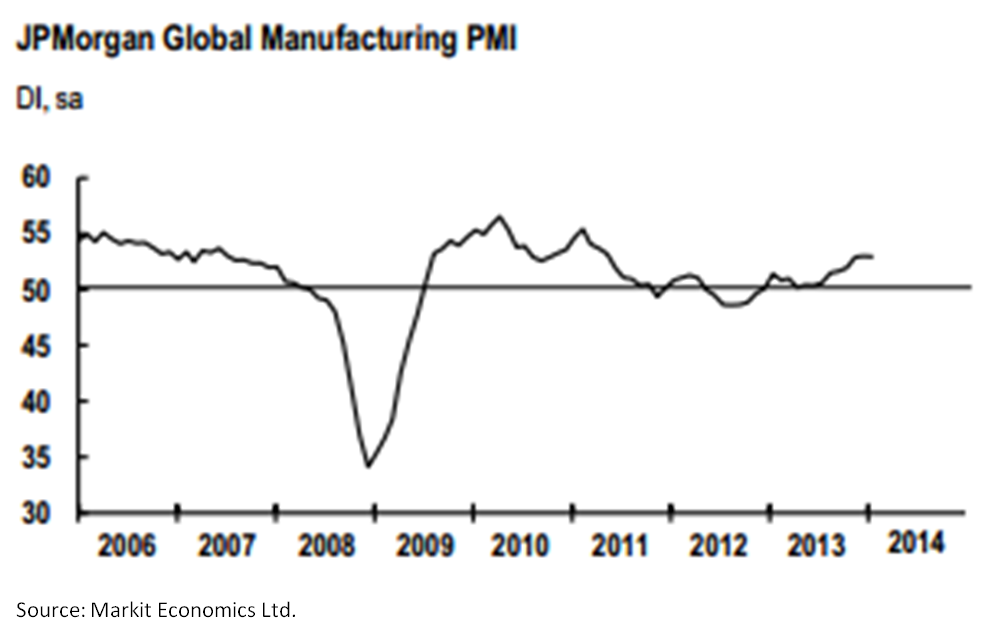Economy

Global PMI Holds Steady in January
Written by Sandy Williams
February 3, 2014
The JPMorgan Global Manufacturing PMI registered 52.9 in January, almost unchanged from December’s high of 53.0 and signaling the fourteenth straight month of expansion. Production and new orders continued upward which helped increase employment levels. New export business slowed in January. Sharp discrepancies in growth were seen between developed and emerging markets. The UK, Japan and Germany were at the top of the PMI rankings while China, Brazil, Russia, India and Indonesia were near the bottom.
 “The global manufacturing sector maintained its solid growth momentum at the start of the year, with production and new orders expanding at rates above their respective averages for the current recovery,” said David Hensley, Director of Global Economics Coordination at JPMorgan. “Manufacturers are also still adding to payrolls, a positive bellwether that they expect the current upturn to run further. Slower inflation of raw material prices will also aid on the cost and profits fronts.”
“The global manufacturing sector maintained its solid growth momentum at the start of the year, with production and new orders expanding at rates above their respective averages for the current recovery,” said David Hensley, Director of Global Economics Coordination at JPMorgan. “Manufacturers are also still adding to payrolls, a positive bellwether that they expect the current upturn to run further. Slower inflation of raw material prices will also aid on the cost and profits fronts.”
Eurozone
The Eurozone expanded at its strongest rate since May 2011. The Markit Eurozone Manufacturing PMI registered 54.0 in January, up from 52.7 in December. Production, new orders, and new export orders all accelerated in January. All the countries included in the Eurozone PMI were in the +50 growth range except for France at 49.3 which reached a 4 month high. Greece showed positive growth for the first time since August 2009. Input costs rose at the slowest pace in four months, while output inflation was moderate for the month. The quarterly growth rate for manufacturing output exceeds 1 percent. Things to watch include pricing pressure and the threat of deflation.
China
China manufacturing conditions deteriorated for the first time in six months as evidenced by weaker growth in output and new orders and dropping employment levels. Average production costs fell resulting in lower output charges. The HSBC Manufacturing PMI inched down to 49.5 from 50.5 in December. Weaker demand was seen in both exports and domestic business activity.
Japan
The Markit/JMMA Manufacturing PMI increased to 56.6 in January from 55.2 in December, its highest reading since February 2006. Output was at a record high along with a sharp jump in new orders. Employment levels increased for the sixth consecutive month as launches of new products and increased production required more staffing. Higher raw materials, including steel, pushed input prices higher. Output prices increased but eased from December’s inflation rate. The weak yen led to higher input prices that were passed along to customers.
South Korea
The HSBC Manufacturing PMI increased only marginally in January to 50.9 from 50.8 in December. Modest growth was reported in new orders and production. Exports were up for the fourth month with higher levels from Europe, North America and Japan. Competitive pressures reduced output prices even as input prices rose. Employment grew at moderate pace in January.
Russia
Manufacturing conditions worsened in Russia with the HSBS Manufacturing PPMI sliding to 48.0 from 48.8 in December. January marks the sixth time in seven months the PMI registered in the contraction zone below 50. Employee cuts occurred at output production declined. Alexander Morozov, Chief Economist (Russia and CIS) commenting on operating conditions said, “The overall picture in manufacturing looks pretty gloomy.”
Brazil
The HSBC Brazil Manufacturing PMI rose to 0.3 points to 50.8 in January. Output made gains at a weaker pace in January despite a surge in new orders. Unfavorable exchange rates resulted in higher prices for raw materials increasing input costs. Output costs rose at the slowest rate in a year-and-a-half due to competitive pressure.
Mexico
Manufacturing in Mexico rose to 54.0 on the HSBC Mexico Manufacturing PMI in January from 52.6 in December. The PMI has been making a strong come back since its stagnation period in September 2013. New orders and production volumes rose at the fastest rate since in a year partially due to a resurgence of export demand from the US and Western Europe. Input costs rose steadily during January and as a result manufactures increased selling prices for the first time since March 2013. Employment levels increased only slightly for the month. The upward trend for manufacturing is expected to continue, pushing GDP growth to 4.1 percent for 2014.
Canada
Canada had a disappointing month for manufacturing activity with output and new business growth the weakest it has been in five months. The RBC Manufacturing PMI dropped to 51.7 in January from 53.5 in December. Softer domestic demand resulted in slower new order growth despite higher export sales. Manufacturers cut pre-production inventories accordingly. Employment levels fell for the first time in two years.

Sandy Williams
Read more from Sandy WilliamsLatest in Economy

Multi-family pullback drives housing starts to 5-year low in May
US housing starts tumbled in May to a five-year low, according to figures recently released by the US Census Bureau.

Architecture firms still struggling, ABI data shows
Architecture firms reported a modest improvement in billings through May, yet business conditions remained soft, according to the latest Architecture Billings Index (ABI) release from the American Institute of Architects (AIA) and Deltek.

Manufacturing in New York state contracts again
However, companies are growing more optimistic about the future.

ArcelorMittal plans wire-drawing closure in Hamilton, shifts production to Montreal
ArcelorMittal’s (AM) Hamilton location to be shuttered, wire production shifting to Montreal.
Beige Book finds growing economic, policy uncertainty
All districts reported "hesitancy and a cautious approach to business and household decisions,” according to the Beige Book.
